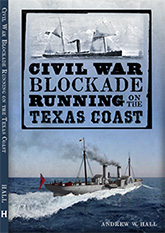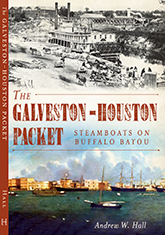The Ghost and John the Drayman
 As the sun rose off Sisál in the Yucatán that Sunday morning in early March 1836, its rays illuminated a couple of dozen vessels anchored off the beach – small, local trading craft, mostly, with a few larger merchantmen displaying the ensigns of other nations – Americans, Hamburg traders, and the like. Two vessels rode at anchor farther offshore, a Texian warship displaying the tricolor ensign of the 1824 Mexican constitution, and her prize, the Mexican trading schooner Pelícano, that had arrived the morning before after a passage from New Orleans.[1]
As the sun rose off Sisál in the Yucatán that Sunday morning in early March 1836, its rays illuminated a couple of dozen vessels anchored off the beach – small, local trading craft, mostly, with a few larger merchantmen displaying the ensigns of other nations – Americans, Hamburg traders, and the like. Two vessels rode at anchor farther offshore, a Texian warship displaying the tricolor ensign of the 1824 Mexican constitution, and her prize, the Mexican trading schooner Pelícano, that had arrived the morning before after a passage from New Orleans.[1]
It was an audacious thing the commander of the Texian schooner Liberty, William S. Brown, and his crew had done just hours before, cutting out Pelícano from the crowded anchorage, almost under the muzzles of a battery of 18-pounders on shore. The Mexican garrison had not been caught off guard; they had noticed Liberty lying well offshore the previous day, suspected her identity, and had taken precautions against any attempted attack by the Texian vessel. Several of Pelícano’s sails had been unbent and taken ashore, a spike was hammered through the jaws of the main boom to immobilize that crucial spar, and – most important – three dozen soldados from the local garrison, under command of an officer, had been put aboard. All these preparations had come to naught. After a short, sharp fight on deck, fourteen of Liberty’s crew had overcome the soldiers and Pelícano’s own crew, leaving six dead, five seriously wounded, and nine prisoners. The rest of the schooner’s defenders had dived over the side and made for the shore; none of the Texians suffered any serious injury.
Now, after spending part of the morning transferring crew, valuables, and sailing gear between the two vessels, Pelícano got underway with orders to proceed across the Gulf of Mexico to Matagorda, some 550 nautical miles away to the northwest. She carried a small prize crew under the command of Liberty’s Sailing Master, Oliver Mayo. After seeing the watch set and being satisfied that all was in order for the time being, Mayo ordered one of the prize crew forward into Pelícano’s cramped galley, to brew some coffee.
The man ordered to perform this task was an odd character, an Englishman by birth, known as “John the Drayman.”[2] He had come aboard at New Orleans a few weeks before. Shortly before he enlisted, a friend of his had hanged himself in the boarding house where they both resided, and John the Drayman believed he was haunted by his dead friend’s spirit. He would, frequently and without warning, suddenly fix his gaze on a distant point, and be overcome with a trembling fear when he saw a vision of the dead man. He would become completely transfixed and immobile when these visions occurred, a dangerous thing aboard ship. Some of Liberty’s crew found this habit to be ridiculous and annoying while others, the more superstitious members of the ship’s company, found it unsettling and frightening. Either way, John the Drayman was an unpopular figure among the crew.
Soon the prize crew caught the scent of roasting beans on the galley stove. Then there was a shriek, and John the Drayman burst on deck, mumbling and ashen-faced. Sailing Master Mayo recognized the problem instantly. “Blast him!,” he said. “He has seen the ghost. Jump in there, one of you, and look after the coffee.” Now Seaman John Lechter[3] went forward, but he passed in one side of the galley cabin and out the other, without stopping. He, too, came out shocked and mumbling. Now the crew genuinely became alarmed.
Mayo was having none of it. He went forward himself, and stuck his head in the little doorway. Now the whole prize crew, following close behind him, heard distinctly a piteous, unearthly moaning coming from within the galley. John the Drayman, having recovered his composure, sarcastically asked his fellows, “why don’t you go in now?”
Sailing Master Mayo, convinced that the mournful wails were from a more conventional source, led forward several of the crew and commenced a search of the galley. They quickly found a tall, cadaverous man, Pelícano’s cook, who had squeezed himself into an impossibly small space behind the galley stove. Stacks of firewood on either side of the stove helped conceal his location. He had hidden himself there when the Texians first boarded the schooner several hours before, convinced that if he was captured he’d be executed on the spot. It seemed like a workable plan, until John the Drayman had struck up a fire to roast the coffee. Now the unfortunate man was hopelessly wedged between a hot stove and the bulkhead, unable either to extricate himself or bear the pain in silence. The prize crew had to unlash the hot stove and drag it away from the bulkhead to get the poor man out, by which time he was half-dead from fear, heat, and exhaustion. After he was revived and recovered enough to speak to his rescuers, he was convinced to sign on to service in the Texian Navy himself, where an experienced cook would always find a welcome berth.[4]
The remainder of the voyage to Matagorda would pass uneventfully, but Pelícano was wrecked on March 15 trying to cross the bar into Matagorda Bay proper. The prize crew escaped, and while salvaging the cargo, discovered gunpowder hidden inside larger casks of flour, fruit, and other provisions. This power was forwarded along to Sam Houston’s Texian Army, then encamped on the west bank of the Brazos River. On March 31, Houston issued a proclamation to the citizens of Texas and the United States describing the military situation in Texas. He specifically singled out the capture of Pelícano, saying “Captain Brown, with one of our vessels, has taken a Mexican vessel, with 240 barrels of flour, 300 kegs of powder, and other supplies for the Army.”[5]
Sadly, John the Drayman was himself not to survive long after the wreck of Pelícano. Now back aboard Liberty after having assisted with the salvage of Pelícano’s cargo, John the Drayman was ordered out on Liberty’s main boom to bring in a line that had come loose in the following breeze. He had got the line and creeping back along the boom when, it seems, his dead friend’s ghost appeared again. John the Drayman clambered to his feet, standing upright on the boom over the water, spread his hands wide, and shouted, “he is coming!” Then John the Drayman fell, the waters of Matagorda Bay closed over him, and he was seen no more.
_______
[1] This story is adapted from S. W. Cushing, Wild Oats Sowings; or the Autobiography of an Adventurer (New York: Daniel Fanshaw, 1857), 164-71, with additional sources as noted.
[2] Cushing does not give John the Drayman’s proper name; if the first name John is correct, he might be Able Seaman John Whitlock, or Seaman John Glover, both believed to be part of Liberty’s crew on this voyage. John Powers, The First Texas Navy (Austin: Woodmount Books, 2006), 218.
[3] Cushing gives Lechter’s last name only; his full name is given in Powers, 218.
[4] This might be one J. Cortes, who is listed as a Cook’s Helper aboard the Texian schooner Invincible, between April 25 and July 10, 1837. Cushing’s account claims the man was Italian, and Cortes generally indicated a Spanish, Portuguese, or Catalan origin. Linda Ericson Devereaux, The Texas Navy: Freedom Fighter for the Republic of Texas Who are Among the Unsung Heroes of the Days of Yesterday (Nacogdoches, Texas: Ericson Books, 1983), 54.
[5] Niles’ Weekly Register (Baltimore), May 7, 1836, 174.
________






leave a comment